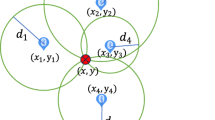Abstract
Localization problem is an important and challenging topic in today’s wireless sensor networks. In this paper, a novel localization refinement algorithm for LAEP, which is a range-free localization algorithm by using expected hop progress, has been put forward. The proposed localization refinement algorithm, called as CVLR, is based on position correction vectors and can resolve the LAEP’s hop-distance ambiguity problem, which can lead to adjacent unknown nodes localized at the same or very close positions. CVLR can make full use of the relative position relationship of 1-hop neighboring nodes (called as CVLR1), or 1-hop and 2-hop neighboring nodes (called as CVLR2), to iteratively refine their localization positions. Furthermore, from localization accuracy and energy dissipation perspective, we optimize the communication process of CVLR2 and propose an energy-efficient improved CVLR. Simulation results show that the localization accuracy of CVLR1, CVLR2, and the improved CVLR are obviously higher than that of LAEP and DV-RND.














Similar content being viewed by others
References
Song, L., & Hatzinakos, D. (2007). Architecture of wireless sensor networks with mobile sinks: Sparsely deployed sensors. IEEE Transactions on Vehicular Technology, 56, 1826–1836.
Wang, J., Chen, P., Chen, J., Sun, Y., & Shen, X. (2011). Target tracking with size estimation in wireless sensor networks. In 2011 International conference on wireless communications and signal processing (WCSP) (pp. 1–5).
El Defrawy, K., & Tsudik, G. (2011). ALARM: Anonymous location-aided routing in suspicious MANETs. IEEE Transactions on Mobile Computing, 10, 1345–1358.
Manap, Z., Ali, B. M., Ng, C. K., Noordin, N. K., & Sali, A. (2013). A review on hierarchical routing protocols for wireless sensor networks. Wireless Personal Communications, 72, 1077–1104.
Yao, Y., & Jiang, N. (2015). Distributed wireless sensor network localization based on weighted search. Computer Networks, 86, 57–75.
Shi, Q., He, C., Chen, H., & Jiang, L. (2010). Distributed wireless sensor network localization via sequential greedy optimization algorithm. IEEE Transactions on Signal Processing, 58(6), 3328–3340.
Naraghi-Pour, M., & Rojas, G. C. (2014). A novel algorithm for distributed localization in wireless sensor networks. ACM Transactions on Sensor Networks, 11(1) Article 1.
Yao, Y., Han, Q., Xu, X., & Jiang, N. (2015). A RSSI-based distributed weighted search localization algorithm for WSNs. International Journal of Distributed Sensor Networks, Article ID 293403, 11 p.
Yeredor, A. (2014). Decentralized TOA-based localization in non-synchronized wireless networks with partial, asymmetric connectivity. In 2014 IEEE 15th international workshop on signal processing advances in wireless communications (pp. 165–169).
Vankayalapati, N., Kay, S., & Ding, Q. (2014). TDOA based direct positioning maximum likelihood estimator and the Cramer–Rao bound. IEEE Transactions on Aerospace and Electronic Systems, 50, 1616–1635.
Shao, H. J., Zhang, X. P., & Wang, Z. (2014). Efficient closed-form algorithms for AOA based self-localization of sensor nodes using auxiliary variables. IEEE Transactions on Signal Processing, 62, 2580–2594.
Zhao, J. J., Zhao, Q. W., Li, Z. H., & Liu, Y. F. (2013). An improved weighted centroid localization algorithm based on difference of estimated distances for wireless sensor networks. Telecommunication Systems, 53, 25–31.
Cheng, W. H., Li, J., & Li, H. Z. (2011). An improved APIT location algorithm for wireless sensor networks. Advances in Electrical Engineering and Automation, 139, 113–119.
Hu, Y., & Li, X. M. (2013). An improvement of DV-Hop localization algorithm for wireless sensor networks. Telecommunication Systems, 53, 13–18.
Wang, Y., Wang, X. D., Wang, D. M., & Agrawal, D. P. (2009). Range-free localization using expected hop progress in wireless sensor networks. IEEE Transactions on Parallel and Distributed Systems, 20, 1540–1552.
El Assaf, A., Zaidi, S., Affes, S., & Kandil, N. (2013). Efficient range-free localization algorithm for randomly distributed wireless sensor networks. In IEEE global communications conference (GLOBECOM) (pp. 201–206).
Wu, G., Wang, S., Wang, B., Dong, Y., & Yan, S. (2012). A novel range-free localization based on regulated neighborhood distance for wireless ad hoc and sensor networks. Computer Networks, 56, 3581–3593.
Yang, S., Yi, J., & Cha, H. (2007). HCRL: A hop-count-ratio based localization in wireless sensor networks. In 2007 SECON ‘07 4th annual IEEE communications society conference on sensor, mesh and ad hoc communications and networks (pp. 31–40).
Ma, D., Er, M. J., & Wang, B. (2010). Analysis of hop-count-based source-to-destination distance estimation in wireless sensor networks with applications in localization. IEEE Transactions on Vehicular Technology, 59, 2998–3011.
Zhong, Z., & He, T. (2011). RSD: A metric for achieving range-free localization beyond connectivity. IEEE Transactions on Parallel and Distributed Systems, 22, 1943–1951.
Arias, J., Zuloaga, A., Lazaro, J., Andreu, J., & Astarloa, A. (2004). Malguki: An RSSI based ad hoc location algorithm. Microprocessors and Microsystems, 28, 403–409.
Heinzelman, W. R., Chandrakasan, A., & Balakrishnan, H. (2000). Energy-efficient communication protocol for wireless microsensor networks. In Proceedings of the 33rd annual Hawaii international conference on System sciences (pp. 1–10).
Cheng, P., Qi, Y., Xin, K., Chen, J., & Xie, L. (2015). Energy-efficient data forwarding for state estimation in multi-hop wireless sensor networks. IEEE Transactions on Automatic Control, Article ID 2461831, 6 p.
Acknowledgments
This work was supported by National Natural Science Foundation of China (Grant Nos. 61100044, 61102066), the Program of Zhejiang Province Natural Science Foundation (Grant No. LY15F010008), and Zhejiang Province Science and Technology Innovation Focused Team Foundation (Grant No. 2013TD03).
Author information
Authors and Affiliations
Corresponding author
Rights and permissions
About this article
Cite this article
Yao, Y., Zou, K., Chen, X. et al. A distributed range-free correction vector based localization refinement algorithm. Wireless Netw 22, 2667–2680 (2016). https://doi.org/10.1007/s11276-015-1129-3
Published:
Issue Date:
DOI: https://doi.org/10.1007/s11276-015-1129-3




